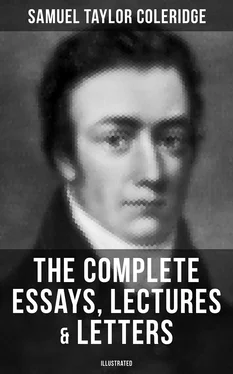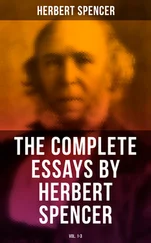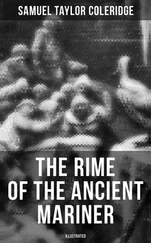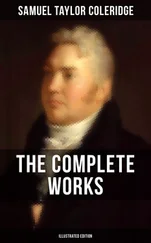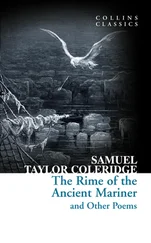CORRUPTIO OPTIMI PESSIMA
"Well" (says Lady Ball), "the Catholic religion is better than none." Why, to be sure, it is called a religion, but the question is, Is it a religion? Sugar of lead! better than no sugar! Put oil of vitriol into my salad—well, better than no oil at all! Or a fellow vends a poison under the name of James' powders—well, we must get the best we can—better that than none! So did not our noble ancestors reason or feel, or we should now be slaves and even as the Sicilians are at this day, or worse, for even they have been made less foolish, in spite of themselves, by others' wisdom.
REIMARUS AND THE "INSTINCTS OF ANIMALS"
I have read with wonder and delight that passage of Reimarus in which he speaks of the immense multitude of plants, and the curious, regular choice of different herbivorous animals with respect to them, and the following pages in which he treats of the pairing of insects and the equally wonderful processes of egg-laying and so forth. All in motion! the sea-fish to the shores and rivers—the land crab to the sea-shore! I would fain describe all the creation thus agitated by the one or other of the three instincts—self-preservation, childing, and child-preservation. Set this by Darwin's theory of the maternal instinct—O mercy! the blindness of the man! and it is imagination, forsooth! that misled him—too much poetry in his philosophy! this abject deadness of all that sense of the obscure and indefinite, this superstitious fetish-worship of lazy or fascinated fancy! O this, indeed, deserves to be dwelt on.
Think of all this as an absolute revelation, a real presence of Deity, and compare it with historical traditionary religion. There are two revelations—the material and the moral—and the former is not to be seen but by the latter. As St. Paul has so well observed: "By worldly wisdom no man ever arrived at God;" but having seen Him by the moral sense, then we understand the outward world. Even as with books, no book of itself teaches a language in the first instance; but having by sympathy of soul learnt it, we then understand the book—that is, the Deus minor in His work.
The hirschkäfer (stag-beetle) in its worm state makes its bed-chamber, prior to its metamorphosis, half as long as itself. Why? There was a stiff horn turned under its belly, which in the fly state must project and harden, and this required exactly that length.
The sea-snail creeps out of its house, which, thus hollowed, lifts him aloft, and is his boat and cork jacket; the Nautilus, additionally, spreads a thin skin as a sail.
All creatures obey the great game-laws of Nature, and fish with nets of such meshes as permit many to escape, and preclude the taking of many. So two races are saved, the one by taking part, and the other by part not being taken.
ENTOMOLOGY VERSUS ONTOLOGY
Wonderful, perplexing divisibility of life! It is related by D. Unzer, an authority wholly to be relied on, that an ohrwurm (earwig) cut in half ate its own hinder part! Will it be the reverse with Great Britain and America? The head of the rattlesnake severed from the body bit it and squirted out its poison, as is related by Beverley in his History of Virginia. Lyonnet in his Insect. Theol. tells us that he tore a wasp in half and, three days after, the fore-half bit whatever was presented to it of its former food, and the hind-half darted out its sting at being touched. Stranger still, a turtle has been known to live six months with his head off, and to wander about, yea, six hours after its heart and intestines (all but the lungs) were taken out! How shall we think of this compatibly with the monad soul? If I say, what has spirit to do with space?—what odd dreams it would suggest! or is every animal a republic in se ? or is there one Breeze of Life, "at once the soul of each, and God of all?" Is it not strictly analogous to generation, and no more contrary to unity than it? But IT? Aye! there's the twist in the logic. Is not the reproduction of the lizard a complete generation? O it is easy to dream, and, surely, better of these things than of a £20,000 prize in the lottery, or of a place at Court. Dec. 13, 1804.
FOR THE "SOOTHER IN ABSENCE"
To trace the if not absolute birth, yet the growth and endurancy of language, from the mother talking to the child at her breast. O what a subject for some happy moment of deep feeling and strong imagination!
Of the Quintetta in the Syracuse opera and the pleasure of the voices—one and not one, they leave, seek, pursue, oppose, fight with, strengthen, annihilate each other, awake, enliven, soothe, flatter and embrace each other again, till at length they die away in one tone. There is no sweeter image of wayward yet fond lovers, of seeking and finding, of the love-quarrel, and the making-up, of the losing and the yearning regret, of the doubtful, the complete recognition, and of the total melting union. Words are not interpreters, but fellow-combatants.
Title for a Medical Romance:—The adventures, rivalry, warfare and final union and partnership of Dr. Hocus and Dr. Pocus.
Idly talk they who speak of poets as mere indulgers of fancy, imagination, superstition, etc. They are the bridlers by delight, the purifiers; they that combine all these with reason and order—the true protoplasts—Gods of Love who tame the chaos.
To deduce instincts from obscure recollections of a pre-existing state—I have often thought of it. "Ey!" I have said, when I have seen certain tempers and actions in Hartley, "that is I in my future state." So I think, oftentimes, that my children are my soul—that multitude and division are not [O mystery!] necessarily subversive of unity. I am sure that two very different meanings, if not more, lurk in the word One.
The drollest explanation of instinct is that of Mylius, who attributes every act to pain, and all the wonderful webs and envelopes of spiders, caterpillars, etc., absolutely to fits of colic or paroxysms of dry belly-ache!
This Tarantula-dance of repetitions and vertiginous argumentation in circulo , begun in imposture and self-consummated in madness!
While the whole planet ( quoad its Lord or, at least, Lord-Lieutenancy) is in stir and bustle, why should not I keep in time with the tune, and, like old Diogenes, roll my tub about?
I cannot too often remember that to be deeply interested and to be highly satisfied are not always commensurate. Apply this to the affecting and yet unnatural passages of the Stranger or of John Bull , and to the finest passages in Shakspere, such as the death of Cleopatra or Hamlet.
A SUNDOG Dec. 15, 1804
Saw the limb of a rainbow footing itself on the sea at a small apparent distance from the shore, a thing of itself—no substrate cloud or even mist visible—but the distance glimmered through it as through a thin semi-transparent hoop.
THE SQUARE, THE CIRCLE, THE PYRAMID
To be and to act, two in Intellect (that mother of orderly multitude, and half-sister of Wisdom and Madness) but one in essence = to rest, and to move = □ and a ○! and out of the infinite combinations of these, from the more and the less, now of one now of the other, all pleasing figures and the sources of all pleasure arise. But the pyramid, that base of stedfastness that rises, yet never deserts itself nor can, approaches to the ○. Sunday. Midnight. Malta. December 16th, 1804.
THE PYRAMID IN ART
I can make out no other affinity [in the pyramid] to the circle but by taking its evanescence as the central point, and so, having thus gained a melting of the radii in the circumference [by proceeding to] look it into the object. Extravagance! Why? Does not everyone do this in looking at any conspicuous three stars together? does not every one see by the inner vision, a triangle? However, this is in art; but the prototype in nature is, indeed, loveliness. In Nature there are no straight lines, or [such straight lines as there are] have the soul of curves, from activity and positive rapid energy. Or, whether the line seem curve or straight, yet here , in nature, is motion—motion in its most significant form. It is motion in that form which has been chosen to express motion in general, hieroglyphical from pre-eminence, [and by this very pre-eminence, in the particular instance, made significant of motion in its totality]. Hence, though it chance that a line in nature should be perfectly straight, there is no need here of any curve whose effect is that of embleming motion and counteracting actual solidity by that emblem. For here the line [in contra-distinction to the line in art] is actual motion, and therefore a balancing Figurite of rest and solidity. But I will study the wood-fire this evening in the Palace.
Читать дальше
